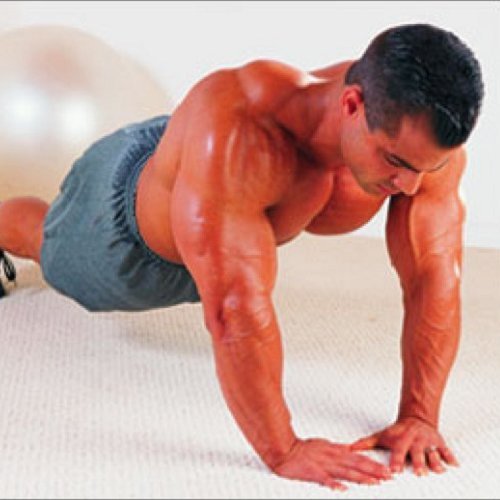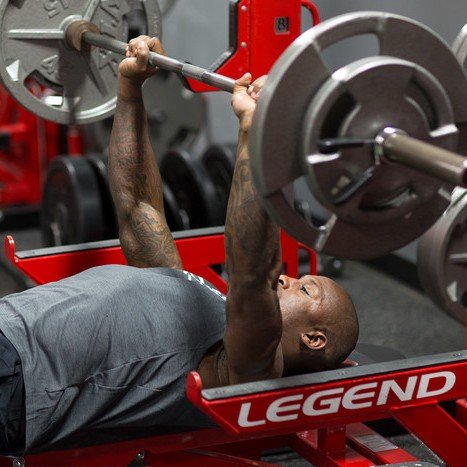The world's strongest people are often best remembered for their most unique single reps—the ones where they did something eye-popping at an unbelievable weight. But what often gets lost in the 1RM glare is that the masters of strength are usually masters of their own bodies first. And being master of your body requires lots and lots of reps of the basics. For example, push-ups.
Yes, push-ups! They've been a stable of fitness routines for decades, if not centuries, but you may have discarded them as being "too easy" years ago. There's no way they build strength, right? Many strongmen from days of yore would disagree. They used the humble push-up to develop their might and muscle, and they definitely didn't do it with 3 sets of 10.
Let's look at a few examples, plus some ways you can bring high-rep push-ups back into your training where it belongs.
Alexander Zass
Alexander "The Amazing Samson" Zass was a Russian strongman who lived from 1888 to 1962. His career aspirations started while he was a prisoner of war, held captive by the Austrians during World War 1. Not content to remain locked in a cage for the duration of the war, he would look for opportunities to escape. Unfortunately for him, he was better at escape than evasion. Before the war was over, he managed to escape four times.
Back in his cell, he would perform push-ups and strain against his bars daily. Eventually, the bars bent. He was able to escape at least once by bending bars and breaking the chains that held him captive.
Most retellings of the Zass story end there. He was the master of isometrics, the bender of bars, breaker of chains—end of story. And while that's certainly impressive, it's not all he did.
Zass emerged from the war a changed man. He now sought to make a living showcasing these same skills he had used to survive. He toured with the circus breaking chains and bending bars in front of stunned audiences. However, at some point during his show, he would drop to the floor and perform 200 perfect unbroken push-ups...in 4 minutes.
I've had the pleasure of knowing some modern-day performing strongmen, and they told me a secret: They will perform a set of an easier exercise before and after a truly demanding feat. For example, they might tear a phone book in halves or quarters before bending a horseshoe or pulling a fire truck by their hair. Of course, it's "easy" for them to tear a phone book, though you and I have no chance of doing even this.
This secret leads me to believe that Zass' push-ups weren't a feat. They were a rest break. After supporting a grand piano with his teeth or pounding a 5-inch spike through a 2-inch thick board with just his hands, push-ups were a welcome break. Have you ever tried doing 200 consecutive push-ups? Go ahead; I'll wait.
Jack LaLanne
Jack LaLanne was a pioneer of physical culture who helped popularize fitness as we know it today. He championed hard work and clean eating until his death at the age of 96. You may know him from the juicer that bears his name, but back in the day, he also had his own television show, where he dispensed workout wisdom and motivation to the first generation of TV viewers. The show was wildly successful, running 34 years.
He was also well known for performing stunts that seemingly no other human could perform, such as swimming from Alcatraz to Fisherman's Wharf in San Francisco while handcuffed, or performing 1000 jumping jacks (named after him) and 1000 chin-ups in 1 hour and 22 minutes.
What you may not know is how he got his big break. In 1956, he was invited on to the "You Asked for It" television show with Art Baker, where he set the world record for consecutive push-ups: 1033 push-ups in 23 minutes. He was 42 years old at the time.
Over time, he became better known for other accomplishments, and even other push-ups, such as the incredibly difficult "LaLanne push-up," which is performed from the fingertips with one or two hands stretched out overhead.
Which is more impressive: a few LaLanne push-ups, or 1000 regular ones? It's a matter of taste. But as impressive as LaLanne's high-rep feat was, it's nowhere near the current world record. In fact, the current Guinness record is so extreme, they changed the category. Minoru Yoshida of Japan set a record for continuous push-ups at a whopping 10,507. Just watching one man perform so many push-ups must have exhausted the judges, because soon after, the criteria changed to account for time, such as most push-ups in an hour or a day.
That shift is a shame in my opinion, because the emphasis on speed has led to a proliferation of half-rep pseudo push-ups. Look in any gym, and you'll see them being performed by the dozen.
C'mon, you're better than that—and the push-up as a muscle-builder deserves better! Cheating your way through a push-up by rebounding out of the hole and not locking your elbows at the top will never add much meat to your frame, for the same reason jumping rope won't add size to your legs. It doesn't produce enough muscle tension. So, let's work making your reps count.
What a Good Push-Up Really Means
For me, a good push-up begins and ends with good spinal position. That means no sagging or exaggeration of your normal spinal curve. If you resemble a devolving semivertebrate mammal when you are in the tall plank position, the rest of these cues will be impossible for you, because your belly will get in the way.
Once you've established your back position, lower yourself down until your elbows are at least past 90 degrees. For even better results, I suggest you rest your chest on the ground and lift your hands off of the ground every rep. This will keep your form tight even when you start to fatigue.
You won't be able to perform as many consecutive push-ups this way as you are used to, but each one will do far more to build a solid training base from which to progress.
Lastly, your arms should fully extend at the top, spreading your shoulder blades. This is the big difference between push-ups and the bench press. If you don't lock out your arms, your scapula will stay locked in place throughout the reps. That extra range is necessary to keep your shoulders happy and strong for years to come.
3 Ways to Get More Push-Ups in Your Life
Some of the strongest people in history have used push-ups in training, but why should you? In the same way that an efficient aerobic system will help a powerlifter recover quickly between sets and workouts, I believe push-ups allow the upper body to recover faster between efforts by increasing vascularity in the arms, chest, and upper back. When you recover faster, you'll be able to lift harder and more frequently, resulting in more potential muscle and strength gains.
This doesn't mean you need to replace your primary lifts with push-ups, though. Here are four ways to get the benefits of push-ups, all of which allow you room for the rest of your training, whatever it might be.
1. At the end of your workout
Push-ups make great finishers. A finisher is just an exercise or grouping of exercises that will allow you to use up the very last of your energy stores at the end of a workout, to jump-start fat loss and muscle gain. Try one of these, then feel free to make up your own:
- Perform 20 push-ups followed by 20 kettlebell swings. With as little rest as possible, perform 18 push-ups followed by the same number of kettlebell swings. Continue working in that manner until you finish with a set of just 2 reps of each.
- Perform 10 push-ups followed by 10 front squats. Continue eliminating 1 rep from each exercise until your last set, where you'll perform 1 push-up and 1 front squat.
2. During rest periods
Perform push-ups during your rest breaks for lower-body movements. If you want to get truly strong, you will have to pair heavy lifting with heavy breathing; there's no way around that.
However, if I'm resting 5 or more minutes between sets, I'll throw in an easy set of push-ups to keep me warm. I find it actually improves my recovery.
3. Throughout the day
Because push-ups don't require any equipment, they can be done nearly anywhere. Even if you can't do them in your workplace, you can fit them in somewhere. At home keeping track of your fantasy football team? Just perform a set of push-ups during every commercial break. If you work in a cubicle, set an alarm to do them hourly.
Find any excuse to push the earth away throughout your day; it's worked for the world's elite fighting units.
4. First thing in the morning
My final recommendation is what I personally do every day. When my alarm goes off, I roll out of bed, let the dog out, and then head straight for my living room where I have a timer set for 5 minutes. I do as many push-ups as I can in those five minutes. Sometimes I add resistance by placing a sandbag on my shoulders; on other days, I see how long I can maintain the bottom position with my chest just off of the ground.
There are dozens of different ways to do push-ups, and in over a year, I have rarely repeated the same workout. My morning ritual has made doing push-ups a habit that I can't start my day without.
Source: http://www.bodybuilding.com/




